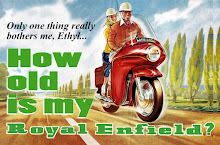 |
| Anne Bradford's book about Royal Enfield in Britain. It's for sale on Amazon and available on Kindle. |
It was one of my proudest moments as an amateur historian of Royal Enfield motorcycles.
In 1933 the press reported that Royal Enfield had delivered a startlingly beautiful, white, V-twin motorcycle to the president of a South American country.
But which one?
By carefully considering the biographies of every president of a South American country of that year, I concluded that none of these men seemed the type to have been interested in motorcycling.
But aha! A president of a Central American nation -- Guatemala -- was famous for his riding, and would lead armed men on motorcycle forays into the countryside, enforcing his dictatorial rule.
It had to be him! I congratulated myself on my discovery and boasted about it in a blog item.
I should have been more modest.
Author Anne Bradford had beaten me to it.
Her renown book, "Royal Enfield, The Story of the Company and the People Who Made it Great: 1851-1969" is a priceless account of the company's history. (It's also known as "From the Bicycle to the Bullet.")
And there, had I bothered to look, I would have found, on the back cover, IN BOLD FACE TYPE, this:
"On the wall of Major Mountford's office was a map with a flag for every agent and you could see we had an agent in every country of the world. We even had one in Guatemala. In fact we supplied the President with a splendid white twin (motor bike) with a mounting for a machine gun across the handlebars, between the two grips. A couple of weeks after it was delivered somebody tried to assassinate him so he sent for some black enamel paint."
 |
| Anne Bradford had the solution to my "mystery." |
I noticed this embarrassing find just after picking up the book. A copy was graciously sent me by Bruce Gipson, a fellow Florida resident, and the owner of a wartime Royal Enfield WD/CO motorcycle.
My proud "discovery" presumably has been on the cover of Anne Bradford's book since it first was published in 1996!
Reading the book I found there was much more I had to learn.
I also discovered that it is more than a history book. It is the affecting story of ordinary (and extraordinary) Royal Enfield employees, told in their own words.
Readers learn not only how these people contributed to Royal Enfield, but how the company intersected with their lives, sometimes through generations.
Hardly a contributor fails to complain about how little they were paid when they worked at "The Enfield," as they called it.
Nevertheless it was home to them, and they gave it their all. Not a few risked life and limb, testing motorcycles in awful weather.
The story begins in 1851, with a needle factory, but the first in-person testimony we get is from Vic Bott, who worked at Royal Enfield from 1920-1968. He was nearly 100 years old when he contributed to the book.
"Consequently I am one of the few people alive today able to describe life as a worker at Royal Enfield in 1920 and the years that followed," he begins. His first task at the factory was to affix linoleum to the floor boards of motorcycles.
Later, having risen to be an engineer and designer, he would create the Royal Enfield Revelation, a miniature adult bicycle with space saving frame and small wheels. The famous story is that he joked he could design the bike in only two weeks. Taken seriously, he then had to do it!
Through war, Depression and decline, employees were loyal. Rita Nati, who stayed until the bitter end, probably exaggerated just a bit when she said this:
"If Royal Enfield came back now to Redditch I would go and work for them without any wages. The firm was great."
Of course the book includes their theories about why Royal Enfield came to an end in Britain.
The market for motorcycles declined as automobiles became affordable. Royal Enfield's plant and products were aged and would cost too much to update. The American market demanded horsepower Enfield designs couldn't provide without losing reliability. The nurturing leadership of R.W. Smith and then his son Frank Walker "Major" Smith came to an end. Vulture capitalists descended, looted the factory, and fouled its future.
But here too are intriguing theories about how the Royal Enfield of those days could have prospered, despite it all.
Those "what-ifs" never happened. And, as a book first published in 1996, it could not foresee Royal Enfield's stunning triumph in India and its surprising 21st century return to Britain and the world.
Which reminds me: Why, all those years ago, did Guatemalan tyrant Jorge Ubico need black enamel paint for his white Royal Enfield?
There apparently had been a plot to assassinate him; at least 12 people were shot by firing squad in 1934 for planning to blow him up in his automobile.
My guess is that the white motorcycle was too showy. Royal Enfield supplied six V-twin motorcycles to Guatemala, three of them in 1933; but only the special one for the president would have been white.
It would have made him a target.
 |
| The resplendent white Royal Enfield 1933 V-twin for a tyrant. |
























That is a great book, and one of my favorites of my RE library.
ReplyDelete